 I didn’t like concluding the first installment of this series with the report of a missing scope, followed by my crabbing about lacking a local source of propellant. So I thought I’d get in an interim update while I’m trying to finish up the last of Christmas shopping. I anticipate being done sometime around June, that is with Christmas related tasks, the muzzle loader article should be wrapped up in a couple of weeks.
I didn’t like concluding the first installment of this series with the report of a missing scope, followed by my crabbing about lacking a local source of propellant. So I thought I’d get in an interim update while I’m trying to finish up the last of Christmas shopping. I anticipate being done sometime around June, that is with Christmas related tasks, the muzzle loader article should be wrapped up in a couple of weeks.Cabela’s politely and professionally came through with a scope to make up for the one that was missing from the kit when received. In fact, the scope arrived at my front door within three days after I reported it missing from the initial shipment. I was so appreciative of the exceptional level of customer service, I decided to place a second order for bullets and a supply of Pyrodex pellets for this project, and other smokeless powder stock for use on future projects. Pyrodex ships under the same classification as smokeless powder, so both can be consolidated into a single shipment to reduce the impact of the $20 UPS hazmat charge. Cabela’s prices are decent, so I was able to cover the UPS hazmat charge, and still come out ahead on cost compared to local retail. Cabela’s has now been added to my list of useful suppliers.
Black powder use takes some metaphysical realignment
 There is something imprecise about using black powder that is unnerving if you split tenth grains to arrive at maximum loads with smokeless powder, or scale weigh cast bullets into fractional grain ranges to avoid over pressure situations. Black powder is measured by volume, not weight, sort of scooped up in a predefined capacity cavity, poured into the bore, then the barrel is thumped on the side to make sure the stuff settles to the bottom of the barrel. Black powder is hygroscopic, that’s pretentious for “soaks up humidity like a sponge”. Consequently, like volumes can vary a good deal in weight, even though the active components are the same – so measuring by volume begins to make a lot of sense.
There is something imprecise about using black powder that is unnerving if you split tenth grains to arrive at maximum loads with smokeless powder, or scale weigh cast bullets into fractional grain ranges to avoid over pressure situations. Black powder is measured by volume, not weight, sort of scooped up in a predefined capacity cavity, poured into the bore, then the barrel is thumped on the side to make sure the stuff settles to the bottom of the barrel. Black powder is hygroscopic, that’s pretentious for “soaks up humidity like a sponge”. Consequently, like volumes can vary a good deal in weight, even though the active components are the same – so measuring by volume begins to make a lot of sense.Black powder is inefficient in combustion, so it takes a lot of powder to make a modest amount of pressure. 130 grains of black powder can generate approximately 30,000 PSI in a top load for a .45 caliber bore, so a grain or two defined by scale measurement would not make a measurable performance difference at even these exaggerated load levels. Most frequently, practice and lighter loads are kept nearer to the 15,000 PSI mark. Black powder appears to be more forgiving, or at least more tolerant of slight variations in charges.
If powder charges can vary, I’d have to say bullet weight seems almost irrelevant; 185 grain sabots, 275 grain PowerBelt can both take the same 150 grain top load in the CVA HunterBolt – the makings for a great one page load data manual. Bullet diameter isn’t very precise either with PowerBelts described as “a little undersize”; actually .458 for the plastic base, .450 for the projectile. The more I play around with this, the more counter intuitive it all seems, and I will have to write reminders to myself to be careful when switching back to more conventional firearms.
Specific propellants
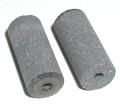
Pyrodex pellets are available in a variety of bore sizes and charges; 45/50, 50/50, 50/30, and 54/60. For my purposes I selected .45 caliber 50 grain pellets. As defined by CVA, the HunterBolt can handle up to three such pellets for a magnum charge, although instructions packaged inside the Pyrodex container indicates no more than 2 50 grain pellets should be used in any firearm. The pellets are directional, a black igniter surface faces into the bore when loading. In addition to pellets, I hope to range test Pyrodex RS, a granulated FFG granular size black powder equivalent, as well as Hodgdon newest product, Triple Seven, which promises more power per volume, ease of clean up and no sulfur smell.
In an apple to apple cost comparison with granulated powder forms, Pyrodex pellets are actually pretty expensive, about $33.60 per pound. However, pellets aren’t sold by the pound, but rather they are packaged in increments of 50 pellets per box, with 2 pellets per shot making up a reasonable powder charge. At a cost of $12 per box of 50 pellets, the cost is approximately half a buck per every time you pull the trigger. At $12/lb for Hodgdon Pyrodex RS, the cost is about 17 cents for each shot fired at the equivalent power level. Just to compound the confusion over cost per round issues, Hodgdon Triple Seven is more expensive per pound, $20, but less is required to achieve the same level of performance from any of the Pyrodex products.
Bullets
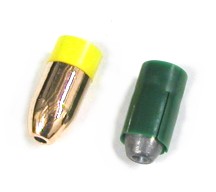 As I indicated in the first installment of this series, the rifle kit from Cabela’s included saboted bullets, but I wanted to try another configuration during range testing so I would be able to develop a better understanding of the cause and effects associated with black powder shooting. PowerBelt bullets, unlike the light weight and under bore .40 caliber cast bullet sabots, are a full .45 caliber and weigh 275 grains. There is a plastic cap at the heel of the bullet that is designed to protect the bullet from pressure cutting, and the copper clad is intended to reduce bore leading that is common to pure lead projectiles. Where saboted bullets require bore cleaning after each round to remove plastic residue, PowerBelt product do not, nor do they require lubrication. The price is $12.99 per 20.
As I indicated in the first installment of this series, the rifle kit from Cabela’s included saboted bullets, but I wanted to try another configuration during range testing so I would be able to develop a better understanding of the cause and effects associated with black powder shooting. PowerBelt bullets, unlike the light weight and under bore .40 caliber cast bullet sabots, are a full .45 caliber and weigh 275 grains. There is a plastic cap at the heel of the bullet that is designed to protect the bullet from pressure cutting, and the copper clad is intended to reduce bore leading that is common to pure lead projectiles. Where saboted bullets require bore cleaning after each round to remove plastic residue, PowerBelt product do not, nor do they require lubrication. The price is $12.99 per 20.Gun Cleaning
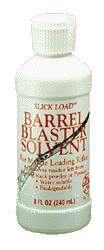 If you’re one of those guys who hates to clean rifles, black powder firearms may not be for you. Every powder container, every rifle manual, every precautionary notice provides a long list of cleaning products and a sequence of steps to follow, dragging patches and brushes through bores and hidden places – concluding with the final caution to take a look down the rifle’s bore a week after cleaning, to check for forming rust. Still, each instruction set points out how much better things now are with cleaner burning powder and better materials used in firearms. I guess the primary deal is removing the powder residue that attracts moisture and promotes corrosion on contact surfaces.
If you’re one of those guys who hates to clean rifles, black powder firearms may not be for you. Every powder container, every rifle manual, every precautionary notice provides a long list of cleaning products and a sequence of steps to follow, dragging patches and brushes through bores and hidden places – concluding with the final caution to take a look down the rifle’s bore a week after cleaning, to check for forming rust. Still, each instruction set points out how much better things now are with cleaner burning powder and better materials used in firearms. I guess the primary deal is removing the powder residue that attracts moisture and promotes corrosion on contact surfaces.In addition to after shooting session cleaning, the use of saboted and patched rounds require bore cleaning between rounds to remove accumulated fouling. Nice thing is most are more liquid soap then petrol based solvents and considerably less expensive than traditional cleaning supplied.
Some mechanical things not common to cartridge firearms
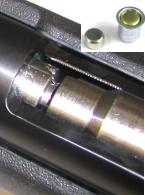 When the bolt is full forward, it is approximately .100″ from the face of the breech plug and #209 primer (inset alongside smaller large rifle primer), leaving a distinct and disconcerting gap for those of use to cartridge firearms with controlled headspace, and bolt faces that more or less see chamber pressure. In test firing the HunterBolt, the primer discharges, the primer indentation is properly formed, and leaking gases color the bolt. I’m sure this is a correct assembly, but I did send an email to CVA for clarification.
When the bolt is full forward, it is approximately .100″ from the face of the breech plug and #209 primer (inset alongside smaller large rifle primer), leaving a distinct and disconcerting gap for those of use to cartridge firearms with controlled headspace, and bolt faces that more or less see chamber pressure. In test firing the HunterBolt, the primer discharges, the primer indentation is properly formed, and leaking gases color the bolt. I’m sure this is a correct assembly, but I did send an email to CVA for clarification.
The HunterBolt rifle’s muzzle is cut to form a recess between the crown and the rifled bore. This recess is approximately 250″ deep, designed to make it easier to start a bullet straight in the bore when loading. The machine work is clean and does not look out of place in the barrel.
Sighting Systems
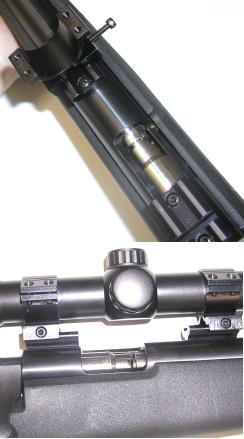
The Woods Trophy Hunter Black Powder Scope Mounting System is a bit huge, and a possibly blackened aluminum mechanically ugly. The bases are Weaver cross slot types that fit the curvature of the action correctly and securely. The lower mounts are slide over types, with a cross screw that locates the mount to the base at the cross slot, then is secured by tightening the cross screw enough to clamp it to the base. The top mounts are held to the lower mounts with 4 socket head fasteners per mount. When in place, the mount system is solid enough for the application, although it is pretty crude in appearance.
The scope supplied in Cabela’s black powder rifle kit is a relatively compact 2.5-7x32mm matte finished shotgun/black powder Pine Ridge model. The shotgun/black powder designation mostly means the scope has a little more eye relief, 4″, and parallax is preset to 50 yards rather than 100 yards. I installed the mounts in a couple of minutes and encountered no problems. The scope plopped in, fitting flush in the mount saddles, and it only took a couple of clicks to square the adjustment with the optical bore sighter grid.
The only very minor glitch was that the scope covers included with the kit, didn’t clear the rear mechanical sight without pushing the sight far forward for clearance. I just need to remember to slide it back if I remove the scope, or plan on the gun being dead on at 1,000 yards.
Overall

With a little clean up, and after completing the set up, this economical CVA package sold through Cabela’s is a pretty nice deal. It looks good, the scope optics are bright and clear, the mechanical sight system is terrific, and the packaged accessories now appear to be a proper selection for this package. All I need to do now is collect some chronographed range data and I’ll be able to better assess how it ranks as a shooter.
There are some odd tasks left ahead that will cause me to live through beginners errors before I’ll be comfortable with the process. As an example, I’ve read through loading instructions a number of times, as well as shooting and cleaning precautions, but I will still need to review proper handling procedures at the range for loading and shooting. I’m looking forward to the experience.
More “Click…., and then bang”:
Click…., and then bang
Click…., and then bang Part II
Click…., and then bang Part III – Conclusion
Thanks
Joe

Email Notification